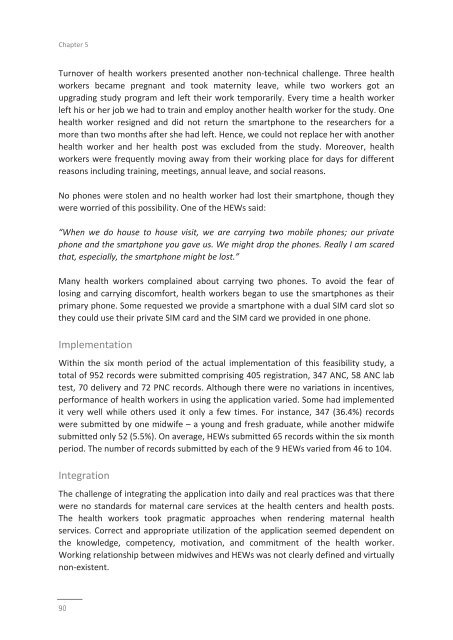araya-thesis
araya-thesis
araya-thesis
You also want an ePaper? Increase the reach of your titles
YUMPU automatically turns print PDFs into web optimized ePapers that Google loves.
Chapter 5<br />
Turnover of health workers presented another non‐technical challenge. Three health<br />
workers became pregnant and took maternity leave, while two workers got an<br />
upgrading study program and left their work temporarily. Every time a health worker<br />
left his or her job we had to train and employ another health worker for the study. One<br />
health worker resigned and did not return the smartphone to the researchers for a<br />
more than two months after she had left. Hence, we could not replace her with another<br />
health worker and her health post was excluded from the study. Moreover, health<br />
workers were frequently moving away from their working place for days for different<br />
reasons including training, meetings, annual leave, and social reasons.<br />
No phones were stolen and no health worker had lost their smartphone, though they<br />
were worried of this possibility. One of the HEWs said:<br />
“When we do house to house visit, we are carrying two mobile phones; our private<br />
phone and the smartphone you gave us. We might drop the phones. Really I am scared<br />
that, especially, the smartphone might be lost.”<br />
Many health workers complained about carrying two phones. To avoid the fear of<br />
losing and carrying discomfort, health workers began to use the smartphones as their<br />
primary phone. Some requested we provide a smartphone with a dual SIM card slot so<br />
they could use their private SIM card and the SIM card we provided in one phone.<br />
Implementation<br />
Within the six month period of the actual implementation of this feasibility study, a<br />
total of 952 records were submitted comprising 405 registration, 347 ANC, 58 ANC lab<br />
test, 70 delivery and 72 PNC records. Although there were no variations in incentives,<br />
performance of health workers in using the application varied. Some had implemented<br />
it very well while others used it only a few times. For instance, 347 (36.4%) records<br />
were submitted by one midwife – a young and fresh graduate, while another midwife<br />
submitted only 52 (5.5%). On average, HEWs submitted 65 records within the six month<br />
period. The number of records submitted by each of the 9 HEWs varied from 46 to 104.<br />
Integration<br />
The challenge of integrating the application into daily and real practices was that there<br />
were no standards for maternal care services at the health centers and health posts.<br />
The health workers took pragmatic approaches when rendering maternal health<br />
services. Correct and appropriate utilization of the application seemed dependent on<br />
the knowledge, competency, motivation, and commitment of the health worker.<br />
Working relationship between midwives and HEWs was not clearly defined and virtually<br />
non‐existent.<br />
90


